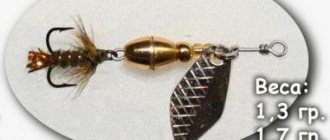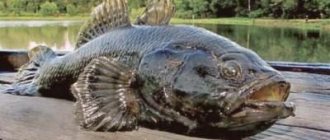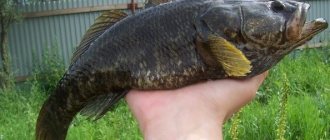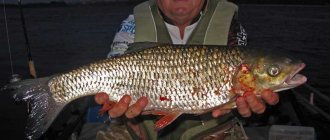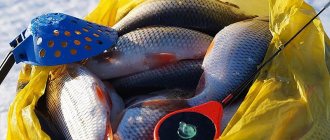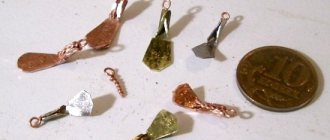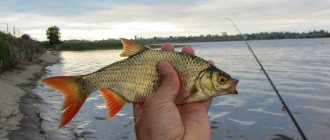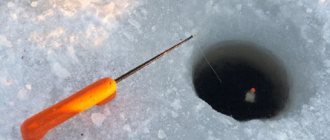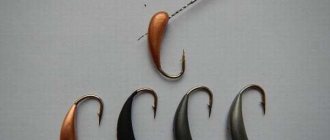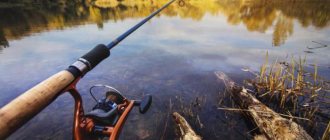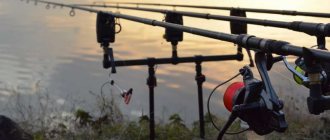Very soon the first ice will form on the water bodies of our region. First, this will happen on small ponds and lakes, and only then on rivers. In order to calm the fishing excitement, and make the long-awaited exit to the first ice not only safe, but also catchable, we advise you to open the ice fishing season by catching rotan in small ponds and lakes in our region, where this predator has spread.
It will be especially interesting to catch it for novice anglers who just want to try winter ice fishing.
If you want to show your children fishing, this is an ideal option for going out on the ice for the first time. It’s very easy to catch a “firebrand”; at the beginning of winter it is extremely greedy and aggressive - it eats itself off for the winter, so it bites on everything that moves nearby. Fine tackle and cunning fishing techniques are not required to seduce him.
Rotan firebrand
Rotan refers to ray-finned fish from the firebrand family, the only representative of the firebrand genus (Perccottus).
Rotan is a terrible representative of the fresh waters of Russia; it is terrible not only for its appearance, but also because if it settles in a closed reservoir, then soon there will be nothing alive left in it - everything will be eaten by this merciless predator. Usually it does not exceed a weight of 100-150 grams, but there are record specimens up to half a kilogram - real cannibal animals, machines for eating everything that fits into a huge mouth!
Rotan is very tenacious and even more unpretentious to oxygen and water quality than crucian carp. Often only these two species remain in the lake and compete with each other. Rotan is too voracious, it eats almost everything, bloodworms and underwater insects, leeches, newts, tadpoles, eggs, juvenile fish, and its own fellows.
Because of its qualities - vitality and gluttony, it displaces all other fish from the reservoir where it has settled. Some fishermen don't like him for this. But as an object of fishing, exciting fishing on the first ice, this is an excellent option. In an overpopulated reservoir, they can be caught in hundreds, one after another.
Migrant – rotan
Rotan or firebrand fish settled in our reservoirs about 25 years ago, and before that only aquarists knew about it. One of them brought this small fish from the Amur and tried to breed it in the pond. Rotan not only took root safely, but also spread throughout the CIS with incredible speed.
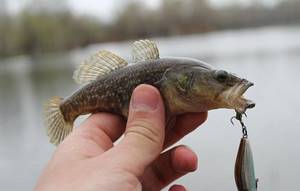
At first it was a real disaster, because the active predator happily ate both eggs and fry of all other species. In just a few years, it replaced crucian carp and other fish in stagnant bodies of water, and in some it became the only inhabitant. Then nature itself intervened in the situation and put everything in its place. The population has decreased significantly, and now the sleeper sleeper, although present almost everywhere, is no longer in such large numbers. Moreover, here it has literally grown: in some lakes, rotan grows to a decent size and gains weight up to a kilogram.
Rotan habitats
As I said above, rotan lives in small lakes, ponds, swamps, where there is no current , and the water often literally rots. He's damn tough. Even crucian carp cannot survive in those conditions, puddles that freeze to the very bottom, where rotan quietly winters, freezing into the mud.
Rotan prefers to stay at shallow depths, close to vegetation. In places where among grass and dying algae, sedge thickets, many larvae and other animal food live.
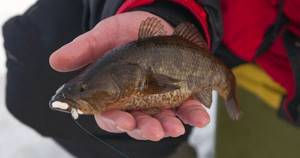
Rotan in winter
Largemouth are not picky about the level of oxygen in the water, like other fish species. This predator lives in frankly bleak waters. But this does not mean that oxygen is not needed. In unfavorable conditions, during freezes, when the reservoir freezes to the bottom, these fish accumulate in large groups, freezing as a ball surrounded by an air-ice mass (which is what people sometimes use). Then in the spring the fish thaw out safely and continue to live.
In ponds that don’t freeze to the bottom, rotan can be caught all winter; it just falls into some kind of torpor in severe cold. Early or late winter is a golden time for largemouth anglers. At this time, the firebrand not only pecks, but in some places there is a wild feeding. Fishing for rotan in the dead of winter is successful where the oxygen in the water remains at a level acceptable for the active life of the fish, and there is food in the reservoir.
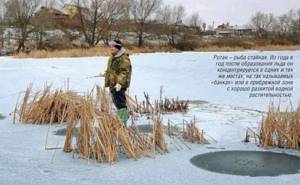
Best time to catch rotan
As soon as the ice freezes, the rotan begins to really eat. This is already an insatiable predator that will never miss a tasty piece in front of its nose, but at the first ice it simply goes berserk. It bites on almost everything, but the best baits are chicken skin, lard, chicken liver, worms and fish meat.
Catching it is simple and very exciting. Therefore, we recommend that beginners who are just starting to master ice fishing practice and get better at catching this particular fish.
Tactics for catching rotan
We drill several holes not far from the shore and old vegetation. Usually there is no point in occupying depths of more than half a meter. We are looking for small depressions in the monotonous topography, remnants of last year’s vegetation, small snags on the bottom in which the concentration of fish will be higher. Rotan does not move much around the reservoir, so it is better to find its site yourself.
After drilling 3-5 holes, it is better to feed them a little jig, small pieces of chopped offal, chopped worms. Then we go around the holes one by one with a jig.
With bait, rotan will gather under the hole faster and will be caught one after another. In some lakes the rotan population is so dense that bait will be superfluous. He will continue to bite as soon as the bait reaches the bottom.
Where, what and how to catch rotan
Rotan is caught throughout the year; the term “season” is not applicable for this fish. At the same time, it does not suffer from weather dependence at all and always feeds: in the heat, during rain or strong wind, and in winter the rotan bites even in a snowstorm. A rotan may not bite for only one reason - the fisherman was unable to find its camp.
The predatory rotan is not as mobile as pike or perch. Unlike them, he does not plow the expanses of the reservoir in search of prey, but sits quietly in ambush and patiently waits for something edible to float by. Therefore, the fisherman’s primary task is to find a place where firebrand fish accumulate. This can be any coastal area that has a lot of natural cover: grass, fallen trees, snags or rocks.
Since rotan is a pronounced predator, only animal baits are suitable for its targeted catching:
- worm (dung, earthworm);
- maggot, bloodworm;
- pieces of fish or meat;
- thin strips of lard;
- chicken skin;
- miniature spinner.
Fishermen specializing in crucian carp fishing claim that firebrands are sometimes caught even on mastyrka. The voracious fish deeply swallows the dough along with the hook, which causes certain problems for the crucian fish. But this is more an accident than a pattern.
The most effective tackle for catching rotan is a fly rod with a length of 3 to 5 meters, equipped with a thin monofilament line, a jig and a side nod. You can experiment with the size and color of the jig, but this will not significantly affect the result.
Fishing technique
No special jig play is required. Rotan also bites when standing. In this case, the jig should be kept at the very bottom, a couple of centimeters away, and make sure that it does not sink into the mud and old dead plants - this will make it easier for rotan to find it. But the best results are obtained by the most uncomplicated game of the jig - small swaying of the bait with stops, so it is easier for the predator to notice the bait and attack more furiously.
It is recommended that a small tip of skin or guts hang from the bait, which will play smoothly and oscillate in the water, attracting a predator. You can also catch rotan using small edible twisters on a micro head, but in my opinion, using a natural bait still gives the best result. They also catch it using microjig, but the reservoirs where it lives in large quantities are usually heavily overgrown with vegetation and silted, which causes certain problems for the spinning angler.
Usually, if rotan is present in the pond, bites will begin immediately. Having caught 3-4 individuals from one hole, you should move to the next, and so on in a circle. The hole rests for 10-15 minutes, and the bite resumes with renewed vigor. Rotan can be caught in bags. If you don’t mind catching anyone, it’s this merciless killer and devastator of water bodies.
Autumn, pond, rotan
It so happened that, having lived in the Moscow region for three years, I somehow never bothered to catch rotan, although even once I purposefully went out to one of the local ponds, but was left without a catch.

The pond where I was left without a catch.
And then one evening after work, my wife and I were walking through our village of Tomilino, and she said to me: “Let’s walk past the pond, we haven’t gone there for a long time.”
And, I must say, there are three ponds in the village, but the one I’m talking about is the most improved, it is rectangular in plan, one long side remains a flat bank, but the opposite side is half and the ends are completely reinforced with logs. True, the improvement was apparently done a long time ago, since the logs are already in a sad state.
Around the pond there is a walking path paved with paving stones, there are benches for vacationers and a children's playground. And during the warm season, a fountain with colored lighting is installed in the pond.
Beauty, in general!

Tomilino, central pond.
So, Lena and I are walking along the path, and then I notice a man with a spinning rod!
The fact is that fishermen with floats sit along the perimeter of the pond more or less regularly; one winter I even saw a “penguin” on the ice, but that was an isolated case, and I thought that the person simply decided to explore a new body of water. Since such precedents were no longer observed, I came to the conclusion that there was nothing worthy of attention in this reservoir.
And, suddenly, you’re wearing a spinning rod!
I, of course, understood that he was catching rotan, I had no information about the presence of another predator in the pond, but rotan is everywhere in the Moscow region, in almost every pond. I understood, but a glimmer of hope still glimmered somewhere inside, but how is there a perch here?
A miracle did not happen - there were no perch in this reservoir...
But while I was talking to the man, I watched how he caught, learned, and understood what my mistake was that time when I was left without a catch.
He was fishing with a “wacky”, I understood this immediately when I went down to him. The worm gliding in the water column was clearly visible, firstly because it was some kind of light, dirty-gray color, and, secondly, this “idiot” was already almost at the very shore, the distance to it was no more than three meters. And during communication, a third thing happened. The silicone worm in the water began to move from side to side, as if someone was pushing it. Naturally, it wasn’t as if it was the bait that was being attacked by rotan, which was hard to see in the muddy water at first, but after looking closely, I did see this robber. The hook was hooked, and after a little resistance the fish found itself above the water, but, fluttering on the bait, it fell back into the water. All! It's decided! Tomorrow after work I’ll take my spinning rod and head to the pond!
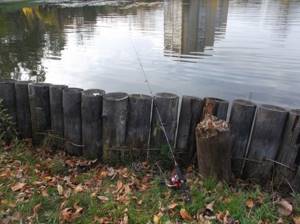
Logs.
And then the evening of the next day came. Fortunately, it takes seven minutes to walk from my office to my house, and five minutes from my house to the pond. In your hands - Aiko Margarita Mr-II-180UL-S, in your backpack - a Shimano Catana 2500 FB reel with a 0.08 monk and two packs of baits, Kinetic Custom Worms 2.75″ from the Chinese manufacturer Rosy Dawn and Troutino 2.5″ from Lucky John.

Caught a fish!
Well, go fish!
I make a cast and repeat the movements that I observed from yesterday’s fisherman - a couple of gentle jerks, just to make the worm bend on the hook and then a long pause. Rewinding the slack line, a couple more tugs and wait...
So what? And they waited! On the fourth or fifth cast there was a noticeable “knock” at the other end of the line and then the bait began to twitch. Chews! But, either he chewed it badly, or I was too hasty with the hook, and, most likely, the latter, I really wanted to quickly catch the first rotan in my life, but “a net came with sea grass.” I didn’t make any concessions to the second rotan, I honestly waited until he chewed on my worm and hooked me! And here it is - the first rotan!
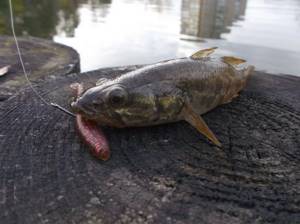
The first rotan!
I have seen many times that this fish is photographed by being grabbed by the lower lip like a bass, but my first one seemed too small to me for such an action, and I made a portrait of it on a log.
Only later, having released the bandit back into the pond, I examined the frame and realized that it was necessary, after all, to photograph the “Russian bass” exactly in the form in which the majority do it. However, it looks more impressive with its fins spread out in all directions.
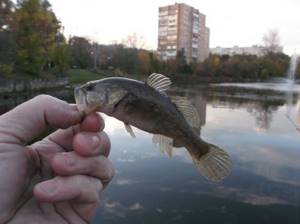
The biggest.
So, having caught a couple of rattans with each of the two baits in a little over an hour, and leaving one pink tadpole from Lucky John in a hook at the bottom of the pond, I ended the day.
I was cold as a dog - the last day of September turned out to be cold and windy, but I was happy as an elephant!
What to cook from rotan?
The meat of the roton is white, quite tender, and although most of the body is occupied by a huge head, it is quite suitable for gastronomic purposes. The largest ones can be fried like any other fish, in breading and a large amount of vegetable oil. And smaller rattans, after beheading, removing the entrails and fins, can be cooked in an autoclave or pressure cooker, just like gobies in tomato sauce. Some people even manage to make fish cutlets from them, but to do this they have to grind the bones several times.

If you have never caught rotan, be sure to try it. This is a very exciting fishing trip where you definitely won’t get bored. If you are wondering where exactly is the best place to go to catch this “beast,” ask about it in the comments.
When and where is rotan caught?
Rotan is a very unpretentious fish. It lives and is caught in winter in such reservoirs as:
- Peat quarries flooded with water;
- Overgrown ponds;
- Flowing lakes;
- River backwaters.
You can meet this fish in heavily polluted water bodies, where there is no other fish besides it.
The choice of place for catching rotan depends on the thickness of the ice cover and the oxygen regime of the reservoir:
- At the beginning of freeze-up, rotan is caught at depths of 1-1.5 meters, near the shore - in a flooded snag, near thickets, aquatic vegetation that has not yet had time to begin to decompose;
- In mid-winter, most of the medium and large rotan move from shallow waters to deep holes. Small rotans remain near the shore;
- At the end of the freeze-up, rotan can be caught again near the shore. At the same time, it is most active in those places where small streams or streams of melted oxygen-saturated waters flow into the reservoir.
Tackle and bait
Rotan is caught using such gear as:
- Winter jig fishing rod - for catching rotan, a simple balalaika fishing rod with a small supply of fishing line 0.12-0.14 mm thick, a flexible nod made of a flat spring or nipple, a large and heavy soldered lead jig of a simple shape (spherical or teardrop-shaped) equipped with hook No. 10-12;
- Winter girders - rotan is caught using simple winter girders (flags), equipped with a monofilament fishing line with a cross-section of 0.22-0.25 mm, and a large single hook No. 6-8. In this case, such tackle is baited not with live bait, but with various meat by-products - chicken skin, lard, beef liver, pieces of fish.
- Rotan is less often caught on vertical and bottom winter spinners and “balda”.
When catching rotan using the gear described above, use the following baits and attachments:
- Bloodworm;
- Chicken skin;
- Fish meat;
- Pieces of lard.
